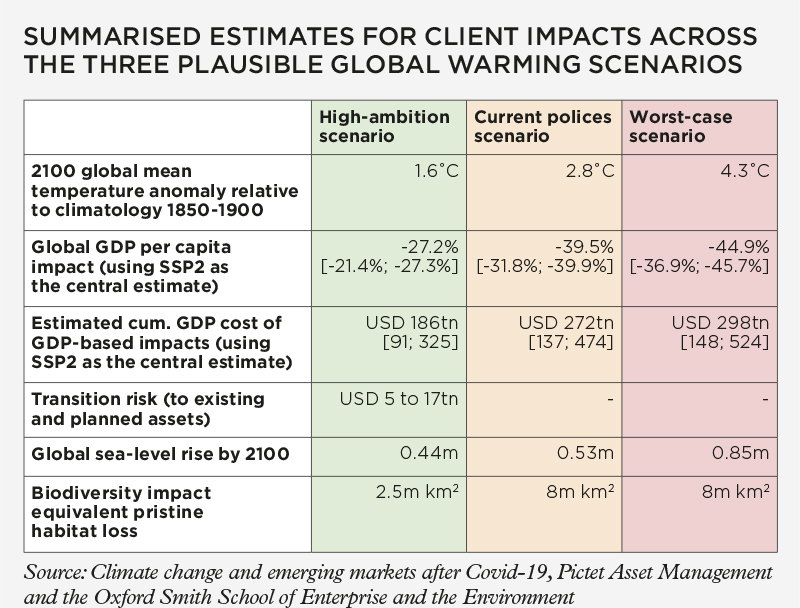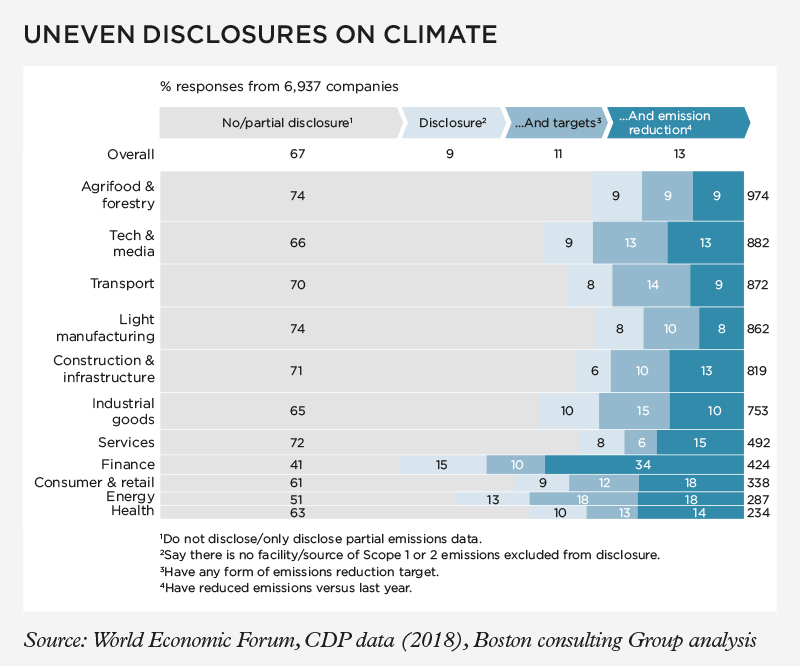As climate risk becomes a key topic on global agendas, how should these risks be reported and mitigated? And what are the opportunities for finance from the transition to net zero?
by Anna Fedorova
This article appears in the October 2021 edition of The Review, published before COP26
The latest edition of the World Economic Forum’s Global risks report, which classifies the key threats facing our planet, names “climate action failure” as the most impactful and second most likely to occur over the next decade, calling it an “existential threat to humanity”.
Climate change is already negatively affecting lives and livelihoods across the globe, and research shows temperature rises are set to hit global economic growth.
A report by Pictet Asset Management and the Oxford Smith School of Enterprise and the Environment, Climate change and emerging markets after Covid-19, published in October 2020, says that in the worst-case scenario – that of a 4.3°C global mean temperature rise by 2100 – the world could lose 44.9% of GDP per capita, costing some US$500tn. Yet the economic hit could be limited to 27.2% of global GDP if the high-ambition scenario of limiting temperature rises to 1.6°C is achieved, according to the report. They consider this to be the best possible outcome, which is slightly above the 1.5°C target of the Paris Agreement.
 According to the Intergovernmental Panel on Climate Change
According to the Intergovernmental Panel on Climate Change (IPCC), the only way we can attain the high-ambition scenario is by reaching net zero carbon emissions around 2050. In an effort to meet this target, governments and companies across the world
doubled up on net zero commitments in 2020.
However, this brings with it the problem of stranded assets, such as oil reserves, which have been unexpectedly or prematurely devalued, written off or converted to liabilities. The Pictet–Oxford report estimates that between US$5tn and US$17tn of existing or planned assets could become stranded under the best-case scenario.
Accordingly, the most carbon-intensive companies are at the highest risk of losses from policies to limit climate change. The Inevitable Policy Response report, published in December 2019 by the UN Principles for Responsible Investment, in collaboration with Vivid Economics and Energy Transition Advisers, says that the 100 worst performing companies in the MSCI All Country World Index stand to lose as much as 43% of their value, equivalent to US$1.4tn. Conversely, the 100 best performers could see their market value increased by 33%. It is therefore crucial for companies to consider climate risk as part of their overall risk assessment.
Identifying climate risksThere are several types of climate risk. Physical climate risk describes the negative impact of extreme weather events. In a 2017 report, global insurer Aon calculates that weather-related natural catastrophes were responsible for 97% of economic losses that year, costing a total of US$134bn. Investors should be aware of how exposed their portfolios are to this risk and what measures are in place to mitigate it. Data from S&P Global shows that 60% of the physical assets owned by the S&P 500 index, with a market cap of US$18tn, are exposed to at least one type of climate change physical risk.
Climate change also poses a transition risk that results from net zero policies, regulatory frameworks and technological developments aimed at slowing global warming.
Changing perceptions of high-carbon industries also mean there is reputational risk for companies that are not displaying a strong effort to decarbonise their operations, which can develop into litigation risk.
Investing in the future
Dr Pooja Khosla, vice president, client development at climate risk analytics platform Entelligent, says financial institutions must invest in climate risk assessment and mitigation to remain competitive and avoid reputational damage. A report by Entelligent – Smart climate: a market approach to transition risk – finds that companies with a high ‘E-Score’ (designed to measure a company’s sector relative exposure to climate change transition risk) outperformed the standard benchmarks in all back-tests from three months to ten years.
“The finance sector still pumps billions of pounds into industries that damage the planet”
However, there is still a long way to go before the finance sector can be hailed as carbon neutral. When ShareAction, a UK non-profit, surveyed 75 of the world’s largest asset managers on responsible investment, 51% of them received one of the two lowest ratings.
Karen Ellis, director of sustainable economy at the World Wide Fund for Nature (WWF), says, “Although it is improving, the finance sector still pumps billions of pounds into industries that damage the planet, and we need urgent and robust action to ensure this sector becomes fully part of the solution.”
Overcoming hurdlesAnother challenge financial institutions face is the availability of climate data. This includes lack of standardisation that makes it difficult to compare sectors, organisations, and even countries like for like, and lack of data in some sectors and geographies, notably emerging markets and smaller companies.
According to analysis by asset manager Neuberger Berman, of around 7,000 companies reporting their emissions to CDP, a global environmental disclosure non-profit, most provide only limited data. Research shows that a high proportion of global companies do not report their Scope 3 emissions, which include all indirect emissions that occur across a company’s value chain.

However, regulators and data experts are putting a concerted effort into solving these problems. For example, the Science Based Target Initiative mandates applicant companies to screen their Scope 3 emissions and set reduction targets if more than 40% of the total carbon footprint lies in the value chain. In addition, many central banks, including those in Europe, the UK and Singapore, are integrating climate change into their stress tests.
The availability of scenarios for transition risk analysis has been expanding over the past year
But the onus remains on financial institutions themselves to carry out the necessary climate risk assessments, says Pooja. And while the task requires the development of robust methodologies and frameworks, she believes the technology for this is already available in the market. “We need financial institutions to partner and collaborate with leading data providers to hone existing technology to better match the needs and outcomes,” she says.
A recent United Nations Environment Programme Finance Initiative report, The climate risk landscape, outlines 18 transition risk tools and analytics available in the market, noting that the availability of scenarios for transition risk analysis has been expanding over the past year.
Some large institutional investors are beginning to put pressure on their investee companies. For example, in 2020, BlackRock, the world’s largest asset manager, requested TCFD-aligned climate-related risk disclosures from all its investee companies by the end of the year (see ‘Reporting drives responsible finance’).
According to Jeanne Martin, senior campaign manager at ShareAction, there are three key actions financial actors can take on this journey:
- Publish a fossil fuel policy in line with climate science.
- Set 1.5°C-aligned expectations for clients operating in high-carbon sectors and sectors that will be heavily impacted by transition and physical risks.
- Publish 1.5°C-aligned targets that cover all their financial services and take into account the social impact of transition away from high-carbon to low-carbon assets.
Climate Risk CertificateAnother important piece of the puzzle for financial institutions lies in the educational element, with climate risk representing a new and complex area of expertise. This was the impetus behind the launch of the new Climate Risk Certificate by the Chartered Body Alliance (an alliance of professional bodies comprising the CISI; Chartered Banker Institute; Chartered Insurance Institute).
OpportunitiesThe transition to a carbon neutral economy creates obvious opportunities in sectors such as renewable energy, electric vehicles and technology. Meanwhile research, including a recent article from MSCI, has found that fossil fuel companies underperform their country indices over the long term.
The financial services sector may be vastly underestimating the earnings opportunities from the transition to net zero
However, Pooja notes that it is, in fact, the biggest carbon producers that have “the highest potential to reduce gross global emissions”. “Targeting the sectors such as energy and utility, which are integral to the economic ecosystem and responsible for most emissions will be critical to helping to progress towards carbon reductions and net zero,” she explains. This can be achieved via transition finance – where the terms of funding are linked to specific climate objectives – as well as via votes at shareholder meetings and engagement with high-carbon companies to help them reduce their carbon footprint over time.
The good news is that, according to a 2020 report by US management consultancy firm Oliver Wyman, the financial services sector may be vastly underestimating the earnings opportunities from the transition to net zero. The firm estimates that while wholesale banks today earn a total of US$80bn from serving “black/brown” corporates such as oil and gas, the green economy could bring incremental revenues of US$50bn–US$150bn across activities, representing what it calls “the single biggest growth opportunity” for the sector.
The road ahead is likely to be bumpy, but the commitments made by governments and corporates, and the regulatory frameworks and reporting requirements being developed to support the transition to net zero, are encouraging.
The full article was originally published in the October 2021 edition of The Review.
The flipbook edition is now available online for all members.
All CISI members, excluding student members, are eligible to receive a hard copy of the quarterly print edition of the magazine. Members can opt in to receive the print edition by logging in to MyCISI, clicking on My account, then clicking the Communications tab and selecting ‘Yes’.
Once you have read the print edition, keep coming back to the digital edition of The Review, which is updated regularly with news, features and comment about the Institute and the financial services sector.